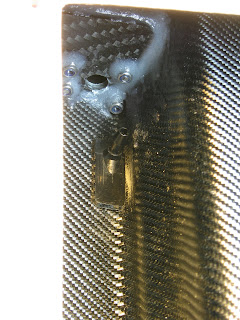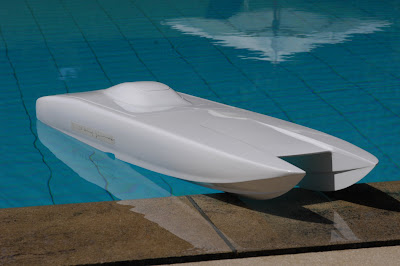I just got back from a visit to Hanspeter Rotschi (
http://www.swissmodelpowerboatteam.ch) and WoW, what a super nice guy and what a super nice hull!! Its got Swiss Quality written all over it :-)
If you are looking for the best 1 meter size offshore cat hull money can buy then this has got to be it, the HPR 06. Its an exact replica of its true life Offshore Class 1 big brother down to every detail including the smallest ones related to the tunnel, sponsons and deck which give this boat handling abilities that no other RC cat in this size class can match (just my opinion).
You can have the boat in three flavors, standard fibre glass, carbon fibre and carbon kevlar; the carbon fibre hull being the most expensive due to raw material costs. All of them are 3 layer with 2 layers of glass fibre and the third layer being glass, carbon or carbon kevlar depending on the version.
I realise that people in the US might feel the cost of this hull is a little high but belive me this is mainly due to high raw material costs and the weak dollar. I have seen hp's invoices for raw material's and I promise you that he is not making a huge profit on these boats and the workmanship is par non!
I bought the Carbon fibre boat which is basically made to order, he does not stock this one so my hull literally came out of the mold the day before I arrived to pick it up :-)
It does not stop there, HP also sells all the important hull related hardware you need to build the boat and every piece fits perfectly which makes for a super nice, no fuss, build.... I think.
Since I have not built one yet I have yet to prove that last point to myself.
I intend to document the build here and help out Hanspeter who's english is not that great by transfering the knowledge he gave me by blogging about the build. I am also trying to target those who do not have much boat building experience (including myself) so bare with me all you guru's.
This will hopefully unload his inbox a little and give him more time to build boats (which is what he does best) and especially to finish his HPR 08 "Mystic" for which he is already back ordered several boats and is slated for production around Sept. 2008 he says. Its the same hull design as the HPR 06 but its 1m85 long and is not a 100% scaled down version of the real things since a few changes have been made primarily to enable the installation of twin Zenoah's in a perfectly vertical manner.
NOTE: Some of you might notice the boat stand in some of my pictures, there was a very limited run of these done by a friend of Hanspeters and they exist no longer. Hanspeter does not sell or have any of these anymore. However if someone is interested I would be happy to trace the profile of both sides of mine and then I am sure it would be fairly trivial to make your own out of wood or whatever.
So to kick things off here are a few pictures of what I walked away with from Hanspeter's "shop"
The Hardware currently sold by Hanspeter for the HPR 06, ain't it beautiful! These engine mounts are for Lehner motors.

And now a few pics of the hull as delivered



















































